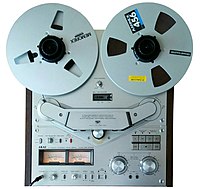
Photo from wikipedia
Introduction Electromyogram-based pattern recognition (EMG-PR) has been widely considered an essentially intuitive control method for multifunctional upper limb prostheses. A crucial aspect of the scheme is the EMG signal recording… Click to show full abstract
Introduction Electromyogram-based pattern recognition (EMG-PR) has been widely considered an essentially intuitive control method for multifunctional upper limb prostheses. A crucial aspect of the scheme is the EMG signal recording duration (SRD) from which requisite motor tasks are characterized per time, impacting the system’s overall performance. For instance, lengthy SRD inevitably introduces fatigue (that alters the muscle contraction patterns of specific limb motions) and may incur high computational costs in building the motion intent decoder, resulting in inadequate prosthetic control and controller delay in practical usage. Conversely, relatively shorter SRD may lead to reduced data collection durations that, among other advantages, allow for more convenient prosthesis recalibration protocols. Therefore, determining the optimal SRD required to characterize limb motion intents adequately that will aid intuitive PR-based control remains an open research question. Method This study systematically investigated the impact and generalizability of varying lengths of myoelectric SRD on the characterization of multiple classes of finger gestures. The investigation involved characterizing fifteen classes of finger gestures performed by eight normally limb subjects using various groups of EMG SRD including 1, 5, 10, 15, and 20 s. Two different training strategies including Between SRD and Within-SRD were implemented across three popular machine learning classifiers and three time-domain features to investigate the impact of SRD on EMG-PR motion intent decoder. Result The between-SRD strategy results which is a reflection of the practical scenario showed that an SRD greater than 5 s but less than or equal to 10 s (>5 and < = 10 s) would be required to achieve decent average finger gesture decoding accuracy for all feature-classifier combinations. Notably, lengthier SRD would incur more acquisition and implementation time and vice-versa. In inclusion, the study’s findings provide insight and guidance into selecting appropriate SRD that would aid inadequate characterization of multiple classes of limb motion tasks in PR-based control schemes for multifunctional prostheses.
Journal Title: Frontiers in Neuroscience
Year Published: 2023
Link to full text (if available)
Share on Social Media: Sign Up to like & get
recommendations!